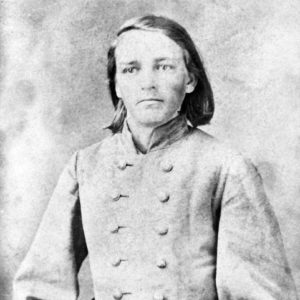calsfoundation@cals.org
Howell A. "Doc" Rayburn (1841–1865?)
Howell A. “Doc” Rayburn was a Civil War guerrilla chieftain who operated in the area between West Point (White County) and Des Arc (Prairie County). His legacy is a mix of fact and legend. His attacks and those of other guerrillas on Union outposts and expeditions tied up countless Union military assets that otherwise could have been used elsewhere.
Doc Rayburn was born about 1841 in Roane County, Tennessee, one of six children born to farmer Hodge Rayburn and Susan Rayburn. A few years later, the family relocated to Texas.
Rayburn joined the Confederate army on October 21, 1861, when he enlisted in Company C, Twelfth Texas Cavalry. The regiment moved to Des Arc in March 1862 and prepared to board steamers that were to carry them to Mississippi. When the regiment departed, they left Rayburn behind with a fever. In 1863, after a long recovery from his illness, he began recruiting local youths to form a guerrilla band. For the next two years, Rayburn and his band was a nuisance to Union military authorities, attacking scouting and foraging parties. In at least one such attack near West Point, Rayburn’s men all donned Union uniforms and took their enemy by surprise. During Confederate general Sterling Price’s 1864 Missouri Raid, Rayburn’s command served as Colonel Thomas H. McCray’s bodyguard. Numerous expeditions were mounted to capture Rayburn, but none were successful.
The most celebrated legend concerning Rayburn centers upon his activities at DeValls Bluff (Prairie County) in December 1864. He told his men that if he could make it through a Union picket line that evening, he would be their Santa Claus. He had a diminutive stature with long blond hair and blue eyes, and at barely 100 pounds, he passed rather easily for a female. Borrowing a lady’s dress and other items, Rayburn made it through the picket line to a Christmas dance hosted by Federal officers. After an evening of dancing, Rayburn made his way to the corral, where he mounted a horse and stampeded enough for each man of his command to receive a horse for Christmas.
Rayburn married Martha Booth, the daughter of a prominent resident of West Point, on June 15, 1865, soon after the Civil War ended.
The exact date of Rayburn’s death is unknown, but he likely died in late 1865 or 1866. Some state that he died of tuberculosis contracted while he was held by Union authorities in Little Rock (Pulaski County) after the war, while others maintain that he was shot by an acquaintance. His gravesite’s location is also a mystery, but it is believed to be in the Des Arc area.
For additional information:
Bailey, Anna, and Daniel Sutherland, eds. Civil War Arkansas: Beyond Battles and Leaders. Fayetteville: University of Arkansas Press, 2000.
Hunsicker, Neva Ingram. “Rayburn the Raider.” Arkansas Historical Quarterly 7 (Spring 1948): 87–91.
Lause, Mark A. Price’s Lost Campaign: The 1864 Invasion of Missouri. Columbia: University of Missouri Press, 2011.
Roberts, Bobby, and Carl Moneyhon. Portraits of Conflict: A Photographic History of Arkansas in the Civil War. Fayetteville: University of Arkansas Press, 1987.
Alan Thompson
Prairie Grove, Arkansas
 "Doc" Rayburn
"Doc" Rayburn 




Comments
No comments on this entry yet.